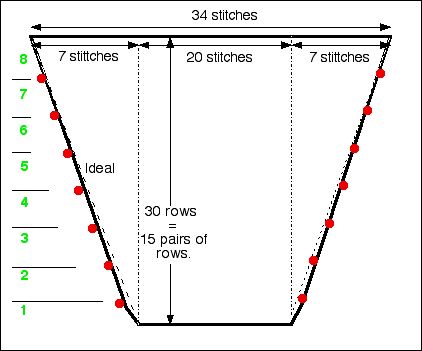|
How to Decrease Stitches Over a Number of Rows
Used when tapering a sleeve knit from the top down.
From The Knitting Fiend.
Your source for free custom generated knitting patterns, tips,
calculating tools and mindless knitting chatter on the web.
This page applies the magic formula,
aka Diophatine Equation, aka 6th grade math, to create directions to
shape a knitted sleeve knit from the top down. I explained "the theory" of sleeve shaping at my blog.
Design considerations involved in using the magic formulas to shape
things like necks, armholes and sleeve caps are explained wonderfully
by Sandee Cherry/Sandee’s Kwik Knit on her CD, Designing 101 Using the Magic Formula.
I have other conversion calculators;
visit my conversion index.
 Note:
SSK stands for "slip, slip, knit", it is the mirror image of "k2
tog" (knit 2 stitches together.) You can decide for yourself
whether you prefer the ssk and k2 tog where I suggest you work
them. You'd get the same shaping with a different decorative
effect if you switched the two operations suggested below. Note:
SSK stands for "slip, slip, knit", it is the mirror image of "k2
tog" (knit 2 stitches together.) You can decide for yourself
whether you prefer the ssk and k2 tog where I suggest you work
them. You'd get the same shaping with a different decorative
effect if you switched the two operations suggested below.
- Hand Knitting in Rows:
- Hand Knitting in Rounds: (I assume you have a central under arm stitch to begin the round.)
- There are stitches on the needle.
- Knit rows but stop knitting last round when there are two stitches left before the underarm stitch.
- Do the following times: ** SSK , knit under arm stitch, k2 tog, knit this round. (You've knit an increase round. ) Knit rows even.** (When you finish, there are stitches on the needle. )
- Do the following times: **SSK , knit under arm stitch, k2 tog, knit this round. (You've knit an increase round. Knit rows even. ** (When you finish, there are stitches on the needle. )
- Tip
for hand knitters. Now that you've read the directions, but your
thinking cap on and consider entering new values above. If you
aren't certain about the sleeve length
you like, or were sloppy about determining your row gauge, add two
stitches to the number you entered in the the bottom row.
If you were correct about your sleeve
length or row gauge, eliminate these extra stitches by decreasing
before knitting the ribbing. If you were a bit off, you'll be
able to
knit a few more rows to get the length you want.
- Machine Knitting Wording:
Have fun knitting!
Lucia
|
|